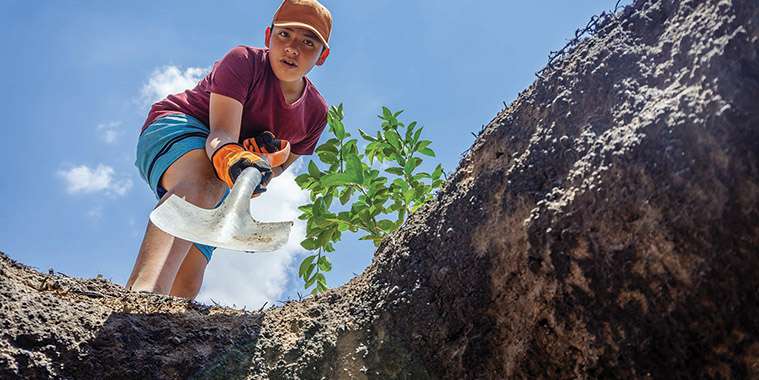The weather is warm, the birds are out, and it’s a great time to take on some outdoor projects. The majority of us try to tackle these projects ourselves.But before you build that new deck, shed, treehouse or gazebo this summer, think first about how you’re going to stay safe doing them. Consider the location and be sure it doesn’t restrict access to the gas meter or emergency gas valve. The utilities should not be located under decks, or inside buildings.
Don’t forget to look up and note the location of any overhead power lines in the work area. Always assume that power lines are energized, even if they’re new installations in the process of being connected. If digging loosens a utility pole, report it immediately to Manitoba Hydro as temporary bracing may be necessary.
Look up and live!
Manitoba Hydro’s power line system includes over one million poles and 90,000 kilometres of wire to distribute electricity to where it’s needed. Power lines are everywhere, so be careful when working around them. Contacting an overhead power line can result in serious injury or death. Follow these tips when working near power lines:
• Look up Before starting any outdoor project at home or at the worksite, check the area to identify where power lines might pose a hazard. Be especially aware of power lines that may be hidden by trees or buildings.
• Stay back 3 metres You don’t have to touch a power line to be shocked — even killed. If you get too close, electricity can jump, or “arc,” to equipment, vehicles, tools, and you. Maintain a distance of at least 3 metres from all power lines.
• Use a spotter No equipment operator working alone can safely judge the distance from the equipment to overhead power lines. A spotter on the ground has a much better view to help you stay clear.
• Carry ladders sideways Never carry ladders upright, as they may contact a power line. Look for overhead power lines before standing up a ladder.
• Plant trees away from overhead power lines Prevent a problem in the future by planting trees where they won’t grow into power lines. Do not prune trees around power lines yourself. Contact a qualified arborist to do the job. See the Right Tree, Right Place document on our website for ideal vegetation options to plant under power lines.
What lies below?
Power lines and natural gas lines may be buried underground. If you’re planning to install a fence, add a play structure, build a deck, or plant a tree, it’s important to find out where it’s safe to dig. In many areas, electrical cables, natural gas pipelines and other utilities are buried under the ground.
Whether you’re a homeowner or contractor, if your project will disturb the ground deeper than 15 centimetres, go to ClickBeforeYouDigMB.com to request a line locate at least three business days before you dig, drill, or excavate.
Digging into an electrical cable can cause serious injury or death. Damaging a natural gas pipe can result in a gas leak, fire, or explosion. Damages can also result in disrupted power or natural gas service to the entire neighbourhood and expensive repairs that you’ll have to pay for.
Don’t put yourself and others at risk. ClickBeforeYouDig is a free service that’s available 24 hours a day, 7 days a week. Once your request is processed, a utility locator will identify electrical cables with red markings and natural gas pipes with yellow. All locates are valid for 14 days.
During the locate, you’ll receive safe digging guidelines to follow. If you’ll be digging within one metre on either side of the markings, you must dig with hand tools, or your project may require a Manitoba Hydro safety representative on site. Always follow the guidelines and drill or excavate with caution.
Remember: digging safe starts with one click or call 1-800-940-3447. It really is that easy, but it’s surprising how many people don’t do this.
Once you’ve mapped out the appropriate areas, check your power tools and accessories thoroughly. Look for wear, breakage, and loose connections. Make necessary repairs and invest in any new tools you may need. Ensure your tools are properly grounded with a three-prong plug. Never break off the third prong so the plug will fit into an outlet — have an electrician install a new outlet instead.
Always use an appropriate heavy-duty extension cord with your tools. Check cords for damage and loose plugs. If a cord feels warm while in use, discard it or have it checked by an electrician. Remember that an extension cord is never a replacement for permanent wiring. Don’t plug more than one high-powered tool into a circuit. When you finish using your power tool, never pull the cord from the outlet — pull it by the plug. This will prevent wear and possible shock. Test your GFCIs regularly to ensure they are providing the protection you require.
By following these simple tips, you’ll be able to stay safe during any outdoor DIY project you tackle this spring or summer. Visit hydro.mb.ca/safety for more information.
— Manitoba Hydro



